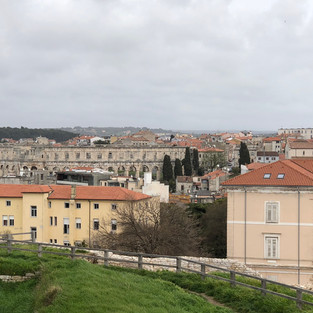Pula, Croatia: a must-see destination on the Istrian Peninsula
- Kevin and Roxanne

- May 9, 2020
- 3 min read

We’ve been writing a lot about our #TravelNear adventures, which might be more practical and useful during quarantine, but damn, I need to relive some of our #TravelFar journeys in hope that we can one day explore our world again!
It’s time to travel vicariously on a #TravelFar journey to Pula, Croatia. Pula is located in the northern region of Croatia called Istria and the largest city in the region. The city is best known for its amazing Roman Amphitheatre. We visited Pula on a rainy spring day in 2018.

The elliptical arena was constructed in the 1st century AD and is astonishingly intact. It was built during the reign of Emperor Vespasian at the same time as the Colosseum in Rome, but the Pula arena is much better preserved compared to the Colosseum. It is said to be the only Roman amphitheater in the world with a complete circle wall that is intact. That seems impressive to me! We wander around this beast, both inside and out, marveling at the ancient structure, with scenes from the movie Gladiator not far from our minds.

Back in the day, the Pula Amphitheatre could seat up to 23,000 spectators to watch the various entertaining events including the gruesome gladiator fights. Today, the theatre is still in use and seats up to 5000 spectators for concerts, opera, ballet, and sports competitions. Stand in the middle of the Amphitheatre and station your friends up in the seats, belt out your best Andrea Bocelli and see how the acoustics work!
Make sure to visit the underground passageways, which have exhibits on the olive and wine production that the region is known for.
The city of Pula makes for a lovely stop or a home base for exploring the Istria region. It’s pedestrian-only cobblestoned streets wind around a central hill that is capped by Pula Castle, a star-shaped castle and fortress built by the Venetians in the 1630s. Some of the stone from the Amphitheatre was used in its construction.

Wander the streets and discover the Arch of Sergii and take your picture with the nearby statue of James Joyce, who lived here in 1904. The simple and elegant Temple of Augustus is located off the main city plaza, The Forum. The Temple was bombed during WW2 but was rebuilt to match its original design.
It it’s starting to sound like Pula is a part of Italy, well for much of its history it has been under Italian control. Istria was a part of Italy until 1947. Italian and Croatia are spoken interchangeably, and Italian food dominates the restaurant menus. Gelato shops fill the street, making it feel like a typical Italian city. This region is known for its wine, olives, and famous white truffles.

As a way to appease Cormac, who was getting a bit tired of all the old stuff, we agreed to a visit to the Pula Aquarium. While not a great aquarium by industry standards, the building was an interesting adaptive re-use of a 130-year old fort that was built during the Austro-Hungarian Monarchy. This made for some interestingly awkward spaces, like a steeply ramped, narrow and long corridor that led from one exhibit to the next.
All-in-all, Pula was a delightful stop. Despite the gloomy day, we were impressed by this city with rich historical sites, walkable streets, and charming atmosphere. Ahh, we can't wait to travel and explore these kinds of destinations again! Until then, enjoy the vicarious journey.























































Comments